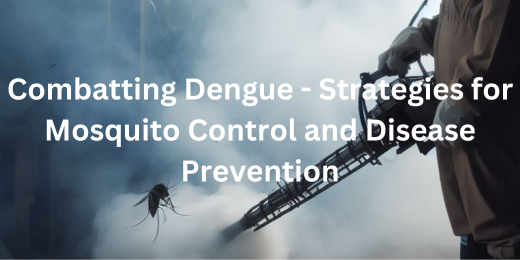Dengue prevention techniques
Dengue, a viral illness transmitted by mosquitoes, poses a significant health threat in many parts of the world. Dengue prevention techniques are vital in curbing its spread. Understanding the virus and its mode of transmission is the first step in this battle. Tropical and subtropical regions are ideal for it to flourish.
The virus is transmitted primarily by the female Aedes mosquito, which is active during daylight hours. This knowledge informs the need for daytime protective measures. Dengue prevention techniques encompass a multifaceted approach, ranging from environmental modifications to personal protection.
By creating mosquito-unfriendly spaces and employing safe, effective mosquito control methods, communities can significantly reduce the risk of Dengue outbreaks. These measures, when combined with community engagement and mobilisation efforts, form a comprehensive strategy for combating Dengue. Similarly, tuberculosis is often referred to as a silent killer due to its ability to spread undetected and cause serious harm if left untreated.
Mosquito Biology and Behaviour: Targeting the Culprits
Understanding the biology and behaviour of mosquitoes is crucial in the fight against Dengue. The principal vector of the Dengue virus is the Aedes mosquito, most specifically Aedes aegypti. These mosquitoes are diurnal, meaning they are active during the day. This behavioural trait is pivotal in devising Dengue prevention techniques.
They are known to breed in standing water, often found in containers around human habitations. Therefore, eliminating stagnant water sources is a key strategy. Mosquitoes are also attracted to human scent, heat, and movement.
This knowledge underscores the importance of personal protection methods, such as wearing long sleeves and using repellents. By comprehending the biology and behaviour of these vectors, we can implement targeted measures to disrupt their life cycle and reduce Dengue transmission. Additionally, it is crucial to learn about measles symptoms and prevention to safeguard oneself from this highly contagious disease.
Environmental Modifications: Creating Mosquito-Unfriendly Spaces
Creating spaces that are unfriendly to mosquitoes is a fundamental aspect of Dengue prevention techniques. Mosquitoes, particularly the Aedes species, thrive in environments with stagnant water. Therefore, one of the first steps in environmental modification is to eliminate standing water sources.
This includes regularly emptying containers, covering water storage, and ensuring proper drainage. Additionally, maintaining well-trimmed vegetation and keeping outdoor areas clean reduces hiding spots for mosquitoes. Screens on doors and windows act as barriers, preventing their entry into homes.
Furthermore, using mosquito nets while sleeping adds an extra layer of protection. Implementing these modifications not only disrupts the mosquito’s breeding cycle but also creates an environment that is inhospitable to their survival. These measures, when combined with other prevention strategies, form a comprehensive approach to combat Dengue. Furthermore, being aware of the effects of mumps highlights the importance of immunization in preventing its spread and minimizing its impact.
Chemical Interventions: Safe and Effective Mosquito Control
Employing safe and effective Dengue prevention techniques often involves judicious use of chemical interventions. In areas prone to Dengue, applying larvicides to potential breeding sites like stagnant water bodies helps curb mosquito populations at their source. Insecticides, especially those approved for indoor use, play a vital role in reducing adult mosquito numbers.
However, it’s crucial to use them with caution, following recommended dosage and application guidelines. Fogging, another chemical intervention, targets adult mosquitoes in outdoor spaces. This method is most effective when used as a supplementary measure, complementing other prevention strategies.
Integrated Pest Management (IPM) approaches, which combine chemical and non-chemical methods, offer a balanced and sustainable approach to mosquito control. By utilising chemical interventions judiciously and in conjunction with other techniques, communities can create a safer environment while effectively combatting Dengue.
Personal Protection: Shielding Against Dengue
Dengue prevention techniques extend to personal protection strategies, serving as a crucial shield against the virus. Since the Aedes mosquito, the primary Dengue vector, is active during daylight hours, wearing long-sleeved clothing can greatly reduce the risk of mosquito bites. Applying insect repellent on exposed skin further fortifies this defence.
Mosquito nets treated with insecticides provide a safe haven during sleep, especially for those living in high-risk areas. Additionally, using screens on doors and windows forms a barrier that prevents mosquitoes from entering indoor spaces.
These measures collectively fortify personal protection against Dengue, greatly reducing the chances of infection. By incorporating these strategies into daily routines, individuals can significantly contribute to the overall effort of Dengue prevention.
Community Engagement: Mobilising for Dengue Prevention
Mobilising communities is a cornerstone in the arsenal of Dengue prevention techniques. Engaging the populace in understanding and implementing preventive measures creates a collective force against the spread of the virus.
Community leaders and health authorities can organise awareness campaigns, educating residents about the importance of eliminating stagnant water, using repellents, and wearing protective clothing. Encouraging regular clean-up drives not only enhances the aesthetics of a neighbourhood but also removes potential mosquito breeding grounds.
Additionally, establishing reporting mechanisms for potential Dengue cases enables swift responses for containment. Beyond individual efforts, fostering a sense of communal responsibility is key. When neighbours unite in the fight against Dengue, the impact is amplified. By mobilising communities, one can forge a formidable defence, significantly reducing the incidence of Dengue in one’s area.



